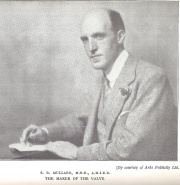Stanley Robert Mullard
Stanley Robert Mullard (1883-1979), radio engineer and industrialist
1883 born in Bermondsey, London, on 1 November, the third of five children of Robert Mullard and his wife, Ann, née Ludford.
Educated privately and at London Electrical Engineering Colleges.
c.1899 Joined Mackey's Electric Lamp Co Ltd, where his father was works manager.
1903 He joined the Institution of Electrical Engineers as a student.
By 1906 was a director of the Mackey company.
1908 married Emmie Gladys Winifred, daughter of George Walter Hole.
1908 Assistant Works Manager Societe Anonyme de Usines Piutsch.
1909 The Mackey company failed
1910-15 In charge of Ediswan's research laboratory at Ponders End, Middlesex. Here he developed the "Pointolite" arc lamp.
1916 Posted to the wireless telegraphy establishment in HMS Vernon to assist in developing silica radio valves for high-powered wireless transmitters.
1916-18, Lieut. R.N.V.R.; attached to R.N.A.S. for wireless duties.
1918-19 Capt. R.A.F.. Head of Wireless Section Research Laboratory, Imperial College of Science, on behalf of Air Ministry.
1919 After demobilization, Mullard was appointed managing director of the Z Electric Lamp Co and also continued his research for the Royal Navy on wireless valves.
1920 The first successful silica transmitting valve, produced in September 1920, had an output of 10 kilowatts on test — sixty times the maximum power from contemporary valves with glass envelopes.
1920 Set up the Mullard Radio Valve Co, which at first used part of the Z-Company's works at Southfields, Wimbledon. Mullard's company was financed by the Radio Communication Co, a bacon producer and a firm of East India Merchants, on the strength of an order for 250 silica valves (at £66 each) from the Admiralty.
1921 Company moved to its own premises in Claybrook Road, Hammersmith. Soon Mullards was selling valves at about half the prices of other manufacturers.
1922 the Marconi group brought a suit against Mullards, alleging infringement of their patents. Mullard fought the case as far as the House of Lords, with judgment given in his favour at every stage. Against Marconi's opinion that the design of valve published in a German book would not work, Mullard made 20 overnight and demonstrated them in a receiver in Court the next day. His small company would probably not have survived without the support of his backers and of the Admiralty.
1923 the company moved to new premises in Nightingale Lane, Balham, increasing its manufacturing capacity to meet the demand for valves for small receiver valves.
c.1923 Stanley Mullard established the Mullard Wireless Service Co to market the valves made by Mullard Radio Valve Co[1]
1925 Because of lack of development capacity, Mullard sold 50 per cent of its stock to N. V. Philips Gloeilampenfabrieken of the Netherlands, in order to benefit from Philips's research and patents.
Marconi acquired Radio Communication Co which reduced the support Mullard received from his shareholders to hold off Philips.
1927 The company became a fully-owned subsidiary of Philips. Mullard was appointed managing director by the Philips board.
1929 For a brief period was involved with the Everlite company which intended to produce a new light bulb.
1929 After considerable friction, Mullard resigned as managing director of both companies, continuining as chairman of the Wireless company[2]. He remained a director until 1970.
Withdrew entirely from the radio industry after this, devoting his time to horticulture.
1979 Died at Haywards Heath, Sussex on 1 September.
See Also
Sources of Information
- Biography, ODNB [2]
- The Times, Jul 25, 1968


